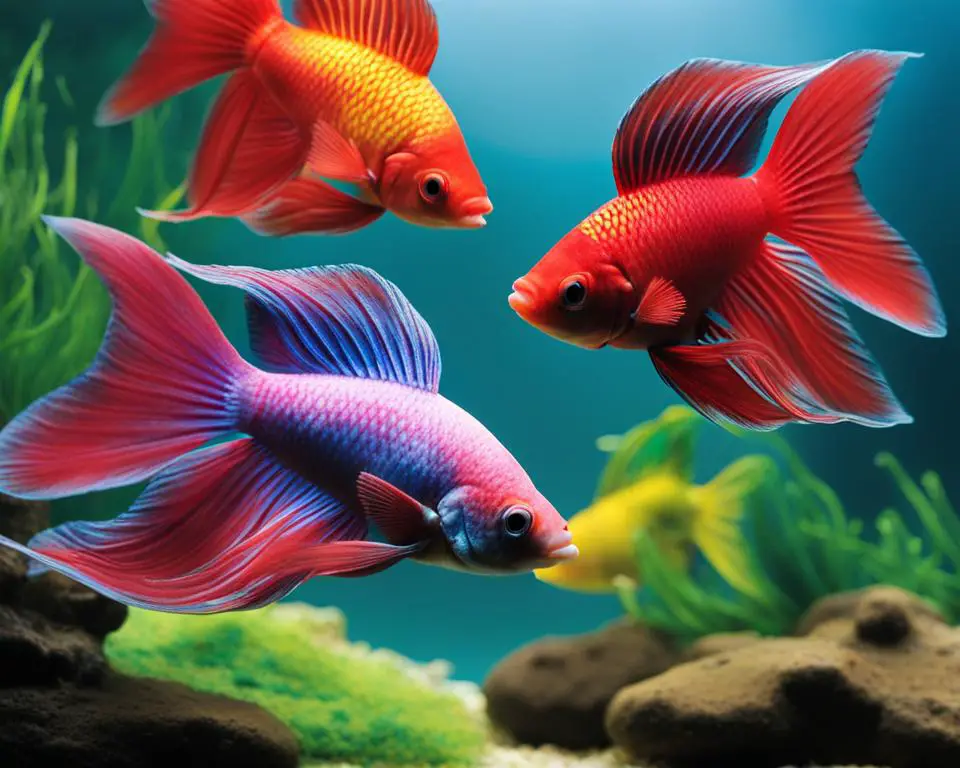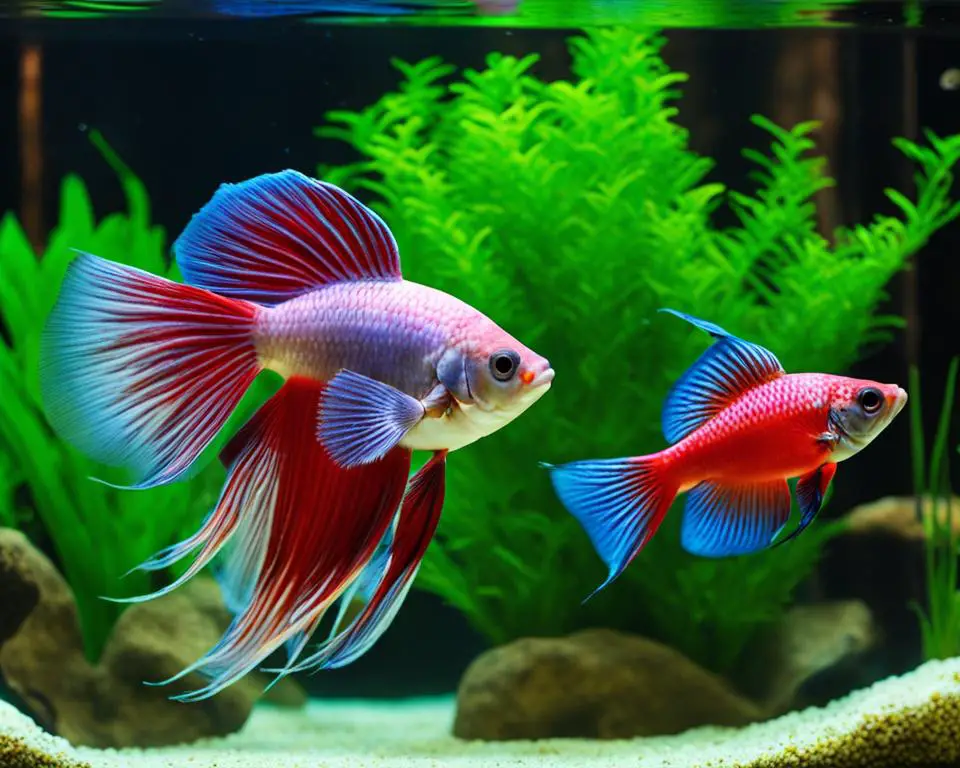If you’re considering adding both Glofish and Bettas to your home aquarium, you may be wondering if these two species can coexist peacefully. While it is possible for them to live together, it’s essential to understand their behavior and compatibility to ensure a harmonious environment. In this comprehensive home aquarium guide, I’ll explore whether Glofish and Bettas can get along, provide tips for housing them together, and discuss factors that can affect their compatibility.
Key Takeaways:
- Glofish and Bettas can potentially live together, but it requires careful consideration of their behavior and living conditions.
- Factors such as tank size and proper hiding spots can affect the compatibility between Glofish and Bettas.
- To promote peaceful coexistence, it’s essential to establish a safe and friendly habitat and deter potential conflicts.
- Understanding the behavior of both species is crucial to promoting successful cohabitation.
- With proper planning and attention to detail, Glofish and Bettas can live together harmoniously.
Understanding the Behavior of Glofish and Bettas
Before considering cohabitation, it’s crucial to grasp the behavior of Glofish and Bettas. Understanding their unique traits and temperaments can help promote successful coexistence. Glofish are genetically modified zebrafish that are generally peaceful, active, and social. They tend to swim in schools, making them an excellent addition to community tanks. On the other hand, Bettas are solitary fish that are territorial and aggressive towards their own species and those with similar characteristics. These traits make them unsuitable for community tanks and better suited for tanks with only a few members.
However, with proper care and attention, Glofish and Bettas can live together harmoniously. When introducing them, it’s essential to establish a pecking order to avoid conflict. I recommend introducing the Glofish first and allowing them to establish their territory. Once they are comfortable, introduce the Betta. This method minimizes the Betta’s aggression towards the Glofish.
In some cases, Bettas may mistake the colorful Glofish for other Bettas and attack them. To prevent this, it’s crucial to maintain good tank conditions, adequate space, and hiding spots for both species. Additionally, it’s crucial to monitor their behavior closely during the first few weeks of cohabitation.
Tip: One way to promote cohabitation is to create visual barriers within the tank to reduce aggression and help establish territories. Adding plants, rocks, and other decorations can create distinct areas for both species and reduce stress.

“Bettas are generally territorial and become aggressive toward their own species and those with similar characteristics.”
Factors Affecting Compatibility Between Glofish and Bettas
Creating an optimal living environment is crucial to ensure the peaceful coexistence of Glofish and Bettas. Here are some of the most important factors that can affect their compatibility:
| Factors | Glofish | Bettas |
|---|---|---|
| Tank Size | A minimum of 10 gallons is recommended for a small group of Glofish. | Bettas prefer a smaller tank of 5 gallons or more. |
| Water Parameters | Glofish prefer a pH between 6.8 and 7.8 and a water temperature of 72-82°F. | Bettas thrive in slightly acidic water with a pH between 6.0 and 7.5 and a water temperature of around 78°F. |
| Proper Hiding Spots | Glofish love to hide in decorations, plants, and other ornaments. Providing plenty of hiding spots can reduce stress and aggression. | Bettas need hiding places to rest and reduce stress. Live or silk plants, caves, and driftwood can be excellent choices. |
Ensuring optimal conditions for both species is essential for their compatibility. A tank that is too small or with poor water quality can trigger stress, aggression, and even diseases. It’s important to monitor the water parameters regularly and perform water changes as needed.
Another crucial aspect is to provide ample hiding spaces for both Glofish and Bettas. Having enough hiding spots can reduce stress and anxiety, allowing them to feel more comfortable in their tank.
Overall, promoting a peaceful coexistence between Glofish and Bettas requires paying attention to their specific needs and preferences. With proper care and attention, you can create a safe and friendly environment where both species can thrive.

Tips for Housing Glofish and Bettas Together
Creating a safe and friendly habitat for Glofish and Bettas is essential for promoting cohabitation. Here are some practical tips for maximizing their compatibility:
- Provide ample space: Glofish and Bettas both require sufficient space to thrive. Aim for a tank that is at least 20 gallons in size to ensure they have enough room to swim and explore.
- Add hiding spots: Bettas are known to be territorial, so adding hiding spots like rocks, plants, and decorations can help create a sense of boundaries for both species.
- Control water flow: Bettas prefer still waters, while Glofish thrive in gently flowing waters. Striking a balance between the two can help minimize potential conflicts.
- Monitor water parameters: Water quality is crucial for the health of both Glofish and Bettas. Keep a close eye on parameters such as pH, ammonia, and temperature, and perform regular water changes to maintain optimal levels.
In addition to these tips, it’s essential to be observant of their behavior and adjust the environment accordingly. If you notice signs of aggression or stress, consider adding more hiding spots or separating the two species into separate tanks.
Promoting Peaceful Coexistence Between Glofish and Bettas
Although Glofish and Bettas can coexist, conflicts may still arise if not managed properly. By deterring potential conflicts and fostering a positive relationship, you can promote a peaceful coexistence between your fish.
1. Provide Sufficient Space
One of the most critical factors for ensuring peaceful cohabitation is providing enough space for both fish to establish territories. A crowded tank can cause stress, aggression, and territorial disputes.
As a general rule, provide at least 2.5 gallons of water per Glofish and Bettas, respectively. A larger tank may be necessary if you plan to keep many fish or other species with these two. Moreover, make sure to create a distinct separation using plants, decorations, or rocks to establish boundaries between their territories.
2. Arrange the Tank Appropriately
It’s vital to arrange your tank in a way that promotes a sense of privacy and security for both fish. Bettas can become stressed if they’re continually exposed to high light levels or stimuli, leading to aggressive behavior.
Ensure that the aquarium is placed in a low-traffic area and provides adequate hiding spots such as plants, caves, or driftwood. By providing hiding spots, you’ll help the fish establish their territories, reduce stress levels, and diminish the likelihood of territorial disputes.
3. Balance the Diet of Your Fish
Proper nutrition is essential for maintaining the health and well-being of your fish. An unbalanced diet may cause aggression and contribute to the development of diseases. To maintain optimal health, your Glofish and Bettas should consume a varied and nutritious diet consisting of fish flakes, pellets, and live or frozen food.
4. Monitor the Tank Conditions
Regular monitoring of water parameters such as temperature, pH, and ammonia levels is crucial for promoting a healthy and peaceful environment. Ensure that the water is adequately filtered and changed regularly to maintain an appropriate environment for both species.
5. Introduce New Fish Carefully
When introducing new fish to the tank, it’s crucial to do so gradually and carefully. Sudden changes in the environment or the introduction of aggressive fish can lead to stress and aggression, leading to territorial disputes and potential harm to your fish. Monitor their behavior closely for a few days to ensure they’re adapting well to their new environment.
“By providing enough space, creating hiding spots and monitoring the tank, you can promote a peaceful coexistence between Glofish and Bettas in your home aquarium.”
Promoting Peaceful Coexistence Between Glofish and Bettas
As a conscientious home aquarium owner, you want your Glofish and Bettas to coexist peacefully. While it may require a bit of extra effort on your part, there are several techniques you can use to deter conflict and foster a positive relationship between these two species.
Create Multiple Hiding Spots
Glofish and Bettas are both territorial, and providing them with multiple hiding spots can help alleviate stress and reduce the likelihood of aggressive behavior. Rocks, plants, and aquarium decorations can all serve as appropriate hiding spots.
Provide Adequate Space
Overcrowding can increase stress levels and lead to conflicts between Glofish and Bettas. Ensure that your tank is large enough to accommodate both species comfortably. A good rule of thumb is to provide at least two gallons of water per fish.
Feed Them Separately
While Glofish and Bettas have similar dietary requirements, feeding them separately can reduce the likelihood of aggressive behavior during feeding times. Use a divider or feeding ring to keep them separated while they eat.
Observe and Monitor
Keep a watchful eye on your Glofish and Bettas and monitor their behavior closely. If you notice any signs of aggression or stress, take appropriate measures to alleviate the situation.
By employing these techniques, you can promote a peaceful coexistence between Glofish and Bettas. Remember, it may take some time for them to adjust to each other, so be patient and persistent in your efforts.
FAQ
Do Glofish and Bettas Get Along?
While Glofish and Bettas can potentially coexist peacefully, it depends on several factors such as their behavior, compatibility, and living conditions. With proper understanding and precautions, you can create a harmonious environment for both species.
What should I know about the behavior of Glofish and Bettas?
It’s important to understand that both Glofish and Bettas have unique traits and temperaments. Glofish are generally active and fast swimmers, while Bettas are known for their territorial nature. By being aware of their behavior, you can promote successful cohabitation and minimize potential conflicts.
What factors affect the compatibility between Glofish and Bettas?
Several factors can influence the compatibility between Glofish and Bettas. The size of the tank, water parameters, and availability of hiding spots all play a crucial role. Providing optimal living conditions is essential to ensure peaceful coexistence between these species.
What are some tips for housing Glofish and Bettas together?
To create a safe and friendly habitat for both Glofish and Bettas, consider the following tips: provide ample space in the tank, maintain proper water conditions, introduce them gradually, and offer plenty of hiding spots. These strategies can help maximize their compatibility and minimize potential conflicts.
How can I promote peaceful coexistence between Glofish and Bettas?
To deter conflicts and foster a positive relationship between Glofish and Bettas, it’s important to monitor their behavior, provide adequate space and hiding spots, and avoid overstocking the tank. Additionally, regular observation and intervention, if necessary, can help establish and maintain a peaceful coexistence.
Can Glofish and Bettas live together in harmony?
While it is possible for Glofish and Bettas to live together harmoniously, it requires careful consideration of their behavior, compatibility, and living conditions. By following the tips provided in this guide, you can create an optimal environment for both species, ensuring a peaceful and enjoyable cohabitation experience.